Table of Contents
TL;DR: How well do the Ryzen 9600X and 9700X processors perform in content creation?
The Ryzen 7 9700X and Ryzen 5 9600X are impressively efficient CPUs, but only see moderate generational performance improvements in certain applications—and nothing in others. Although they promise an MSRP reduction over the Ryzen 7000, the frequent and ongoing price reduction on the previous-gen processors means that most users would pay a small premium for the new CPUs (at least for now), a value that they don’t quite justify. However, they do handily secure AMD’s lead over Intel in most relevant workflows at this budget level, and do so at lower power, lower cost, and, hopefully, lower failure rate.
Introduction
Following some launch delays, AMD has now released the first two CPUs from their new Ryzen 9000 series of processors: the Ryzen 7 9700X and the Ryzen 5 9600X. These CPUs are based on AMD’s new Zen 5 CPU architecture, which promises increased IPC (Instructions Per Clock) and improved efficiency—in addition to better memory support. These CPUs are compatible with existing AM5 Motherboards (e.g., X670E), which support DDR5 and PCI-e 5.0, although there are also updated X870 boards that should be available later this year.
Since we plan to have a review of the full Ryzen 9000-series of processors (including the Ryzen 9 9900X and Ryzen 9 9950X) around their launch date of August 15, this will be a more limited review looking at the overall performance of the two lower-end SKUs. We also plan to investigate performance compared to older generations as well as examine the power draw of this new generation in future articles.
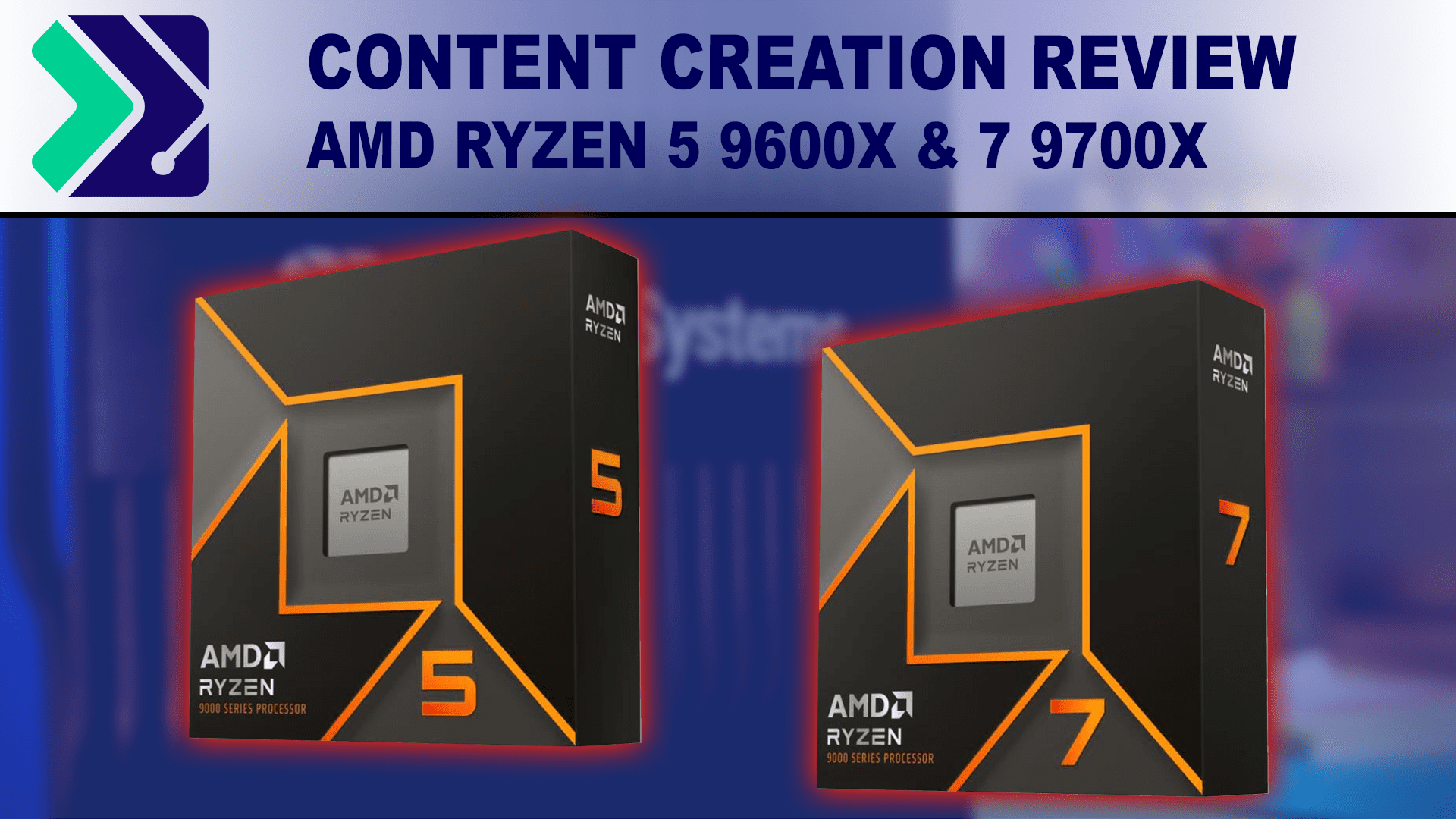
Below, we have listed the most relevant CPU specifications from AMD and Intel. For more information, visit Intel Ark or AMD’s Ryzen page.
| CPU Model | MSRP (ASP) | Cores (Threads) | Maximum Boost Clock | TDP (Max) | Release Date |
|---|---|---|---|---|---|
| Intel Core i7-14700K | $410 ($400) | 8P + 12E (28) | 5.6 GHz | 125 W (253 W) | Oct. 2023 |
| AMD Ryzen 7 7700X | $400 ($300) | 8 (16) | 5.4 GHz | 105 W (~130 W*) | Sept. 2022 |
| AMD Ryzen 7 9700X | $360 | 8 (16) | 5.5 GHz | 65 W (~90 W*) | Aug. 2024 |
| Intel Core i5-14600K | $320 ($300) | 6P + 8E (20) | 5.3 GHz | 125 W (181 W) | Oct. 2023 |
| AMD Ryzen 5 7600X | $300 ($210) | 6 (12) | 5.3 GHz | 105 W (~130 W*) | Sept. 2022 |
| AMD Ryzen 5 9600X | $280 | 6 (12) | 5.4 GHz | 65 W (~90 W*) | Aug. 2024 |
Overall, there are relatively few changes between Ryzen 7000 and Ryzen 9000 in terms of base specifications. Core count and Cache are identical, and base and maximum frequencies are very similar. Some key differences are that the 9000-series processors support higher maximum memory frequencies (5600 Mbps vs. the Ryzen 7000’s 5200 Mbps), have lower TDP (and measured wattage), and feature some additional capabilities, such as native AVX512 support. One interesting caveat is that, in a 4-DIMM configuration, the Ryzen 9000 series processors downclock memory to the same 3600 Mbps as the Ryzen 7000 series processors, so the increased RAM speed support is only if you are using two sticks. The new processors look to be very efficient compared to previous Ryzen chips and Intel’s similarly-placed CPUs, although we will note that AMD’s published TDP numbers can be misleading as they do not reflect real-world power draw (which is why we are also listing the max power draw we recorded).
Figuring out how much a CPU should cost—especially for AMD CPUs—has historically been very difficult due to frequent sales combined with occasional supply issues and MSRP adjustments. Due to this, we have included both the listed MSRPs for all CPUs and the 6-month average sales price on Newegg / Amazon. It is typically the case that AMD has much larger sales than Intel, which means that, although the MSRP shift seems large from Ryzen 7000 to Ryzen 9000, the change in actual cost to an average buyer is relatively small. Even though the new Ryzen CPUs have a lower MSRP than the previous generation, due to the almost constant sales and deals for the Ryzen 7000 processors, the new 9000-series are likely to be more expensive than the average price of the CPUs they are replacing. Most likely, the average end-user cost for Ryzen 9000 will come down over time, but at the moment, they will likely be $60-70 more.
Test Setup
Intel Core Test Platform
| CPUs: Intel Core i7-14700K Intel Core i5-14600K |
| CPU Cooler: Noctua NH-U12A |
| Motherboard: ASUS ProArt Z690-Creator WiFi BIOS version: 3603 |
| RAM: 2x DDR5-5600 32GB (64 GB total) Running at 5600 Mbps |
| GPU: NVIDIA GeForce RTX 4080 16GB Driver Version: Studio 555.99 |
| PSU: Super Flower LEADEX Platinum 1600W |
| Storage: Samsung 980 Pro 2TB |
| OS: Windows 11 Pro 64-bit (22631) |
AMD Ryzen Test Platform
| CPUs: AMD Ryzen 7 9700X AMD Ryzen 5 9600X AMD Ryzen 7 7700X AMD Ryzen 5 7600X |
| CPU Cooler: Noctua NH-U12A |
| Motherboard: ASUS ProArt X670E-Creator WiFi BIOS Version: 2122 AGESA v Combo AM5 PI 1.2.0.0a |
| RAM: 2x DDR5-5600 32GB (64 GB total) Running at 5200 Mbps for Ryzen 7000 Running at 5600 Mbps for Ryzen 9000 |
| GPU: NVIDIA GeForce RTX 4080 16GB Driver Version: Studio 555.99 |
| PSU: Super Flower LEADEX Platinum 1600W |
| Storage: Samsung 980 Pro 2TB |
| OS: Windows 11 Pro 64-bit (22631) |
Benchmark Software
| Photoshop 25.9.1 – PugetBench for Photoshop 1.0.1 |
| Premiere Pro 24.5 – PugetBench for Premiere Pro 1.0.1 |
| After Effects 24.5 – PugetBench for After Effects 0.96 |
| DaVinci Resolve 18.6.6.7 – PugetBench for DaVinci Resolve 1.0 |
| Cinebench 2024 |
| Blender 4.0.0 |
| V-Ray 6.00.01 |
To investigate the performance of the new AMD Ryzen 9600X and 9700X processors, we tested them against the current equivalent 14th gen Intel Core processor and the last-gen AMD Ryzen 7000-Series processors. If you are interested in how the 9000-series compares to even older Ryzen CPUs, we will be looking at the Ryzen 9 5950X and Ryzen 9 3950X in our forthcoming AMD Ryzen 9000 Series vs. Previous Generations article.
As recent events with the Intel 13/14th Gen have shown, the power settings used when running a processor can significantly affect performance, stability, and longevity. Because we do our performance testing through the lens of a workstation system integrator, we tend to prioritize the latter two over the former; this means that we disable overclocking and ensure that processors are run in line with manufacturer specifications. We have done a lot of testing to ensure that this has only a minimal impact on overall performance, but it does mean that our numbers do not always wholly align with other reviewers.
For clarity, when testing AMD processors, we disable ASUS’ Medium Load Boostit, AMD’s Precision Boost Overdrive, and run our memory at the maximum-supported JEDEC frequency and timings. For our Intel platforms, we disable ASUS’ Multi-Core Enhancement (MCE) and Intel’s Adaptive Boost Technology (ABT), limit PL1 to 125 W, PL2 to 253 W, set Tau to 56 s, set ICCMax to 307 A, and run the memory at the maximum-supported JEDEC frequency and timings. For more information about the performance considerations of some of these settings, see our articles on how power settings affect performance in Content Creation workloads for AMD Ryzen 9000 (upcoming) and Intel 14th Gen.
As is typical, our benchmarks consist of a mix of various industry-standard benchmarks, including our own PugetBench for Photoshop, Premiere Pro, After Effects, and DaVinci Resolve. We also test with third-party benchmarks such as Cinebench 2024, V-Ray, and Blender. These give us targeted, real-world performance numbers for a variety of content creation applications and help inform us about the components’ performance in other uses.
Graphic Design: Adobe Photoshop

Starting off with Adobe Photoshop, the new Ryzen 9000-series processors see an 8% performance improvement from the previous generation. Although not the largest generation gap AMD has ever seen, it is a solid gain and even more impressive when you consider the new chips’ lower power. This also solidifies AMD’s lead over Intel in this workflow, with AMD seeing an 18% higher score over Intel’s 14700K and a 27% over the 14600K from comparable chips.
Previous readers may notice that these results are substantially different from previous times we have examined CPU performance in Adobe Photoshop. Since our last CPU review, we have fully launched our PugetBench for Adobe Photoshop v 1.0, which features an overhaul of the tests to better align the benchmark with modern photo editing and graphic design workflows. We plan all our benchmarks around what people are doing in the real-world first, and letting the hardware perform as it does, and in this case, it ended up being to the benefit of AMD, allowing them take the performance lead over Intel Core in our Photoshop benchmark.
Video Editing: Adobe Premiere Pro
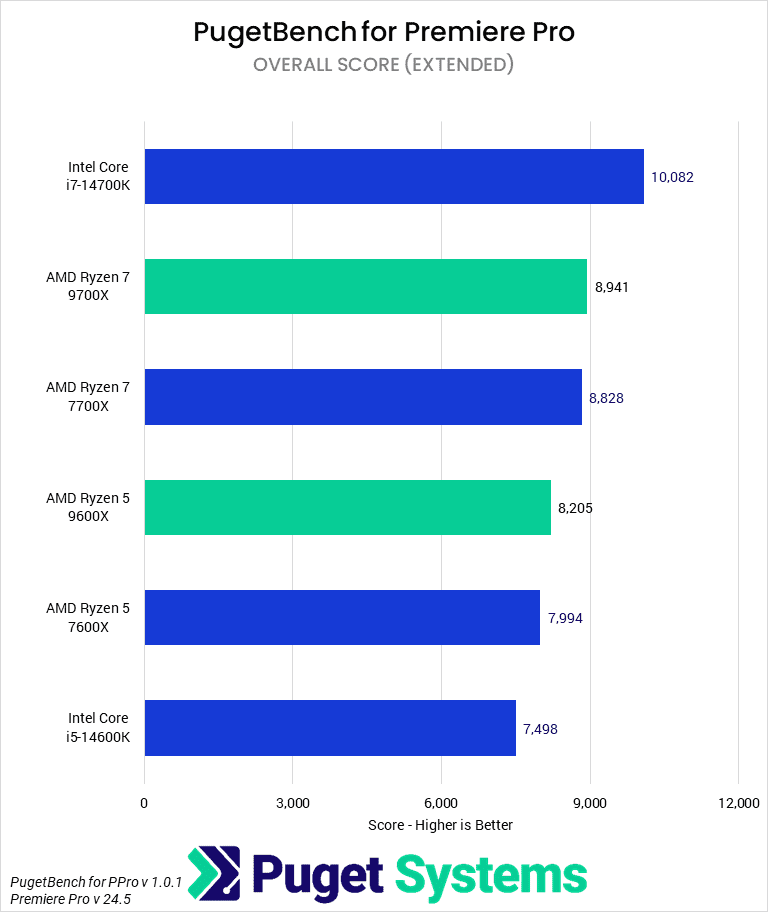
Premiere Pro has much more muted gains for AMD than Photoshop, with the new CPUs within what we would normally consider the margin of error for our tests. Although we are confident there is a small performance gain given our repeated validation of these results, it does mean that there is little gain in upgrading from last-gen for video editing in Premiere—the only advantage is lower power draw.
This is partly due to the fact that Premiere Pro is a more mixed application than Photoshop, utilizing a combination of CPU, GPU, and hardware acceleration depending on the specific workload. Since all our platforms are using the NVIDIA GeForce RTX 4080, you get less of a difference between CPU models than you do in more pure CPU-based applications. There are specific tests in our benchmark that show more nuanced results than this overall score, and we will dive into that in more detail when we publish our full Ryzen 9000-Series article with the Ryzen 9900X and 9950X.
This also means that AMD is in the same spot in comparison to Intel as they were before the new CPUs launched. In general, Intel tends to benefit in Premiere Pro due to their Quick Sync technology accelerating the processing of some codecs, especially HEVC 4:2:2 10-bit. Although we will be digging into sub-results more in our full article, Intel generally enjoys a strong lead when that is a required part of a workflow but is otherwise on par with AMD.
Motion Graphics: Adobe After Effects
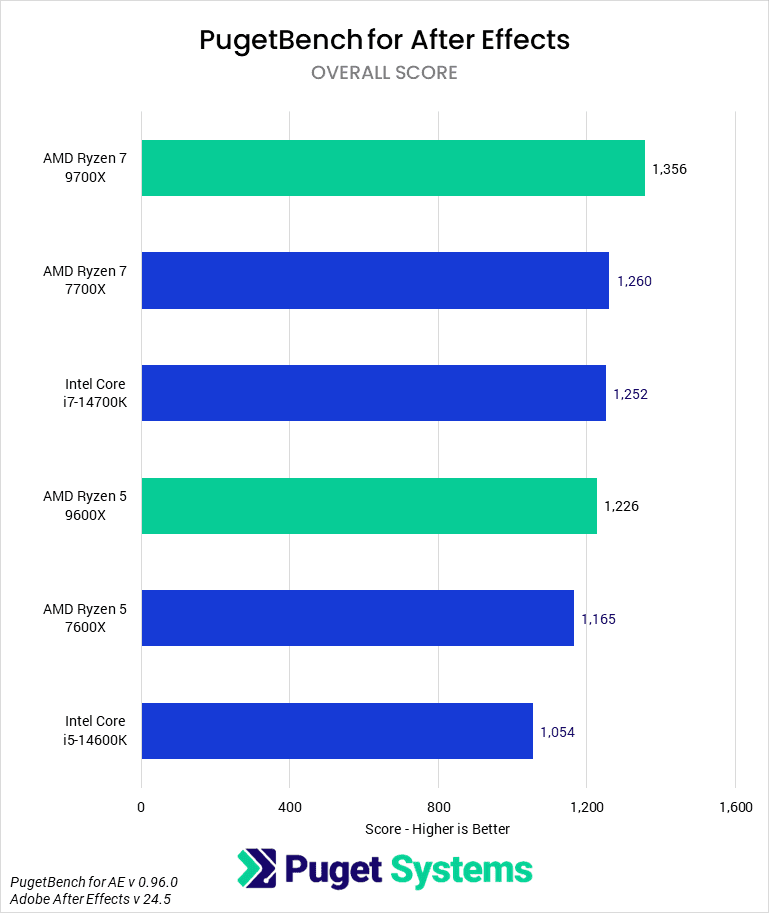
Adobe After Effects is a slightly stronger application for AMD’s new Ryzen 9000 processors than Premiere Pro, though still behind the overall gains in Photoshop. The Ryzen 7 9700X CPU sees a 7% uplift over its last-gen counterpart, while the Ryzen 5 9600X enjoys a 6% lead. Both of these are relatively small but still notable in that they secure the lead for AMD over their Intel competitors. This doesn’t make the Ryzen 9000-series CPUs a particularly compelling upgrade from the Ryzen 7000, but they are certainly a better value at MSRP for new systems.
Video Editing / Motion Graphics: DaVinci Resolve Studio
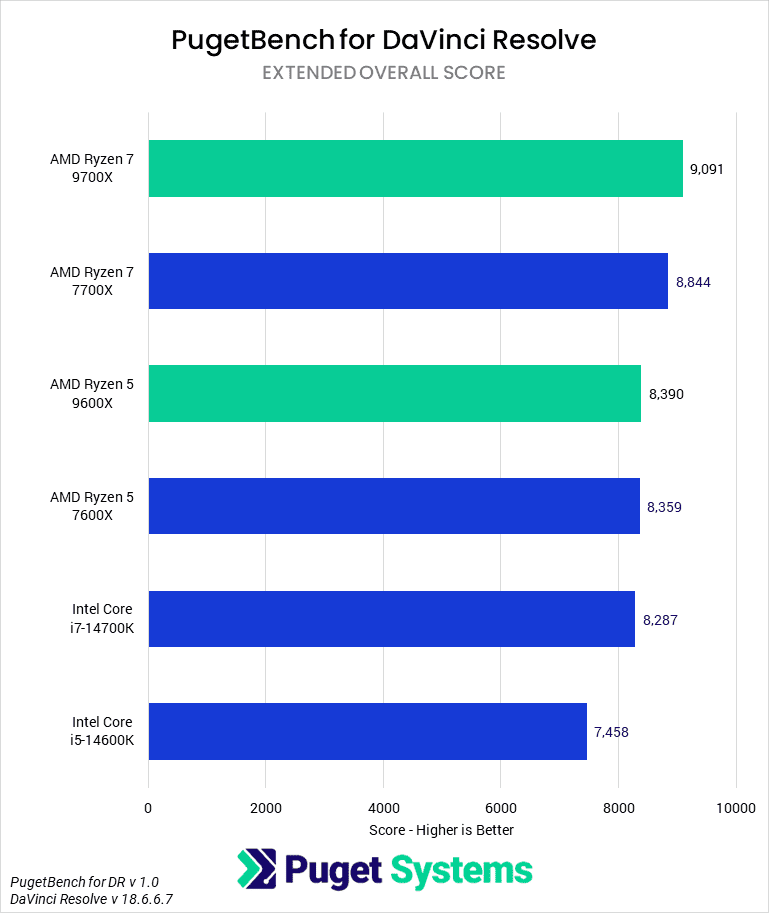
Much like Premiere Pro, AMD only makes small gains in DaVinci Resolve and makes them relatively unexciting across the board. Again, the same performance at a lower power draw is impressive, but current users of Ryzen 7000 systems need not upgrade. Between Intel and AMD, the Ryzen 9600X and 9700X are generally faster than their Intel counterparts, although, like Premiere Pro, there are nuances to the results that we will dive into more in our upcoming full Ryzen 9000 article.
CPU Rendering: Multi-Core
Rendering is a mixed bag for AMD, with some engines like V-Ray showing larger performance gains of 15% while others like Blender and Cinebench showing a much more modest 3-5%. Many of AMD’s IPC gains in this generation only materialize in specific, more modern workflows, so whether or not they are worth the upgrade from Ryzen 7000 will depend on the specific application.
Compared to Intel, AMD tends to fall behind at this tier of CPU due to the large core-count disparity Intel achieves through its hybrid architecture. This is especially the case given that we tend to have lower multi-core performance from Intel due to our conservative power targets. In general, a consumer CPU like (non-Threadripper) Ryzen or Intel Core isn’t really designed to be a dedicated rendering machine, as AMD’s Threadripper or Epyc CPUs provide far higher performance and memory capacity. Instead, many users with this class of hardware will tend to prefer GPU rendering. Still, if it is a portion of your workflow, the new CPUs offer a moderate performance bump, depending on the individual renderer.
CPU Rendering: Single-Core
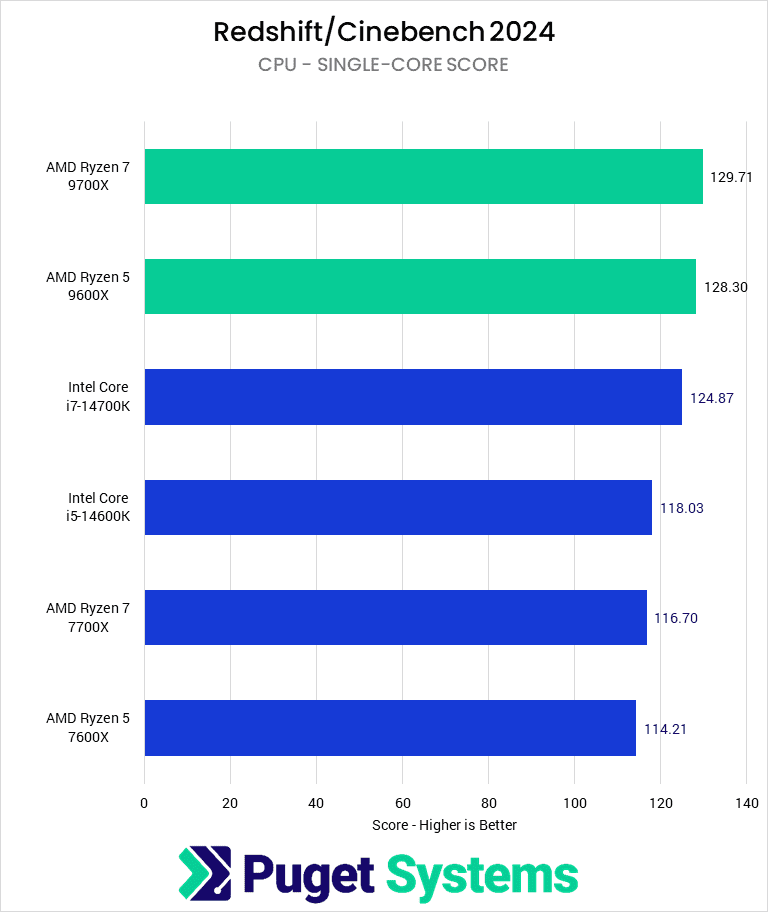
Single-core CPU rendering is not a real-world workflow that anyone does, but it can be a useful proxy for certain other applications, such as non-simulation performance in CAD or 3D modeling software. In the Cinebench 2024 single-threaded benchmark test, AMD makes solid gains of 11% over the previous gen. This takes them just ahead of Intel’s 14700K and means that they may be a superior option for single-threaded performance in some workflows.
How good are the Ryzen 7 9700X and Ryzen 5 9600X for Content Creation?
Overall, AMD’s new Ryzen 7 9700X and Ryzen 5 9600X are competent CPUs with great efficiency. They managed to meet or exceed their last-gen counterparts by 5-10% while drawing 40 W less power at max (a reduction of 30%). This also brings their power consumption well below even Intel’s base power draw values, and they manage to do so without sacrificing much performance, handily beating equivalent Intel processors for many of our tested workloads.
For video editing, motion graphics, and related tests, the new CPUs averaged about a 5% uplift in performance over the previous generation, although it tended to be hit or miss, depending on the application. Applications that benefited—Photoshop and After Effects—frequently saw a 10% gain, while the others—DaVinci Resolve and Premiere Pro—saw virtually no benefit. We wouldn’t recommend upgrading from a last-gen CPU for these workflows, but these may offer a solid value from older systems (which we will be evaluating in an upcoming article).
In rendering applications, we saw much the same, but with higher margins. While Cinebench multi-core and Blender saw no performance improvements, V-Ray saw a 15% increase in score and Cinebench single-core a 10%. These are solid generational improvements, but again, they are only realized on certain applications. Much like video editing, the new CPUs are most compelling as an upgrade from a system 2+ generations old.
There are a few elephants in the room that we need to address. Firstly, although AMD’s Ryzen 9000-series of processors seem to be cheaper than their Ryzen 7000-series based on MSRP, for most end-users, they will actually end up being notably more expensive (at least at first). AMD has consistently been dropping the realized cost of their CPUs since they launched, and over the last 6 months, the 7700X has averaged $300 and the 7600X a mere $210. The MSRP of the new processors comes in at $60-70 above this, a substantial percentage price increase without the subsequent performance gains to go alongside it. Their efficiency is impressive, but energy costs will not offset that price gap. Most likely, AMD will employ the same strategy with the Ryzen 9000-series processors, and prices will drop over time, but we expect it to be a little while before that happens.
Second, as many of our more tech-focused readers are likely aware, Intel has recently been in the news for a number of issues causing high failure rates and permanent damage to their 13th- and 14th-generation CPUs. Although we haven’t experienced nearly as much of that issue as others in the industry (see our President’s blog post for our experience and views so far), it is still a factor to bear in mind when comparing Intel and AMD processors. We are confident in our workstation configurations, but we encourage caution when purchasing an Intel CPU right now until we see whether Intel’s promised microcode update addresses the issue.
Overall, the Ryzen 7 9700X and Ryen 5 9600X processors are impressively efficient, but at their current price, are not the best in terms of value compared to AMD’s previous Ryzen 7000-series of processors. However, this is just for the lower-end Ryzen 5 and 7 processors, and we have yet to fully review the Ryzen 9 9950X and 9900X. The 9950X we are especially looking forward to, as it does not have a drop in TDP compared to the previous generation like the other models, which will give us a good idea of how Ryzen 9000 compares to the previous generation when running at the same power draw.
If you need a powerful workstation to tackle the applications we’ve tested, the Puget Systems workstations on our solutions page are tailored to excel in various software packages. If you prefer to take a more hands-on approach, our custom configuration page helps you to configure a workstation that matches your exact needs. Otherwise, if you would like more guidance in configuring a workstation that aligns with your unique workflow, our knowledgeable technology consultants are here to lend their expertise.








